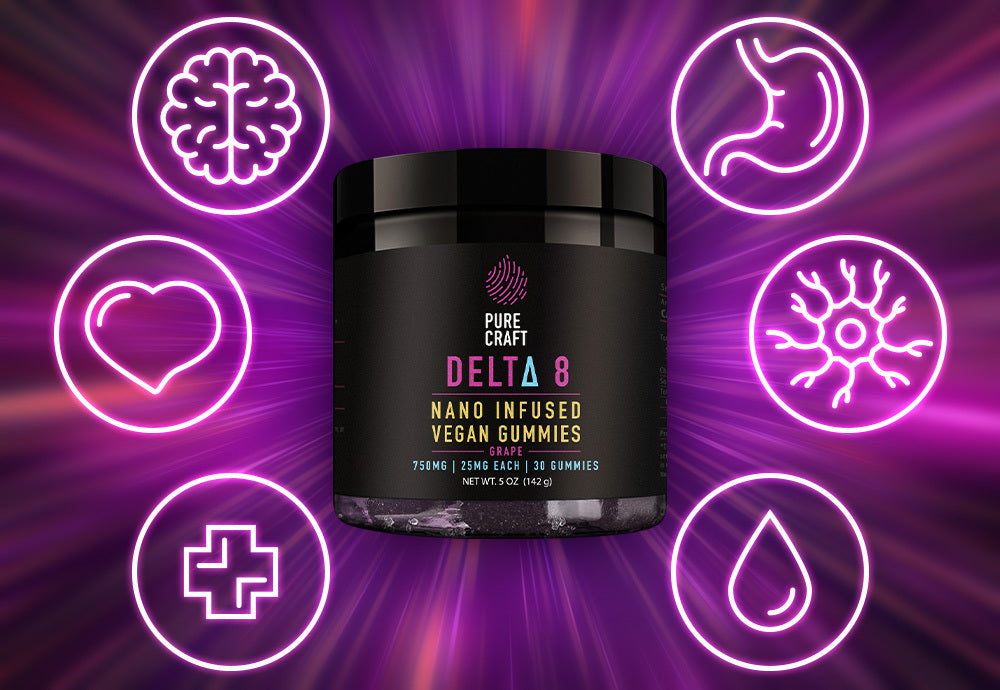Your Cart is Empty
FREE SHIPPING ON ORDERS $70+ | SATISFACTION GUARANTEED
CBD (cannabidiol) is a compound extracted from the cannabis plant. Many people buy products infused with CBD oil to help ease pain, reduce inflammation, improve their sleep, or reach other wellness goals.
Being an all-natural substance, you might think making CBD oil is a cut-and-dry process. It comes from a plant. How complex could it be?
There’s actually a lot of detail involved in CBD production. Experienced people and careful calculations are required at every stage to make the operation successful — and legal.
Maybe we’re biased, but we find the whole CBD production process to be fascinating. We detailed each step below, so keep on reading for a behind-the-scenes look at how CBD’s made.

First things first, let’s get clear on what CBD oil is.
CBD oil is an oil derived from cannabis, which could be of the hemp or marijuana variety. After CBD is extracted from the plant, it’s in a highly-concentrated form. So, the pure CBD oil is mixed with other oils (known as carrier oils) to make the CBD oil used in CBD products.
Marijuana contains higher concentrations of THC than CBD, whereas hemp has higher CBD concentrations and lower THC content. This reflects in the THC content of the CBD oil.
If you’ve heard of hemp seed oil, you might be wondering if that’s the same as hemp-derived CBD. The short answer is nope! Hemp seed oil comes from hemp seeds and it doesn’t contain CBD or THC.
The process of making CBD oil is fundamentally the same for marijuana-derived CBD oil and hemp-derived CBD oil, but hemp products are consistently regulated in all 50 states.
Since we’re purveyors of hemp-derived CBD products, we’ll walk you through the process of making CBD oil from industrial hemp.
With so many processes, measurements, and moving parts, making high-quality CBD oil is part art and part science.
The process of making CBD starts with a seed. After all, the hemp plant must exist so CBD can be extracted from it.
For organically grown hemp and cannabis, the soil is tested for fertilizers and pesticides before the hemp seeds are planted.
Growing hemp without agricultural chemicals isn’t always easy. Some organic hemp cultivation methods can increase the THC content in the crop making it illegal to use. Pest control can also get tricky. Experienced hemp farmers learn how to overcome these challenges to deliver the ideal final product.
Once hemp seeds are in the ground, it takes around four months for the plants to be harvest-ready.
For industrial hemp, crops must be tested by the Department of Agriculture in the state they’re grown in before harvesting. This federal law is enforced by states to make sure the THC content doesn’t exceed 0.3%. If the crop exceeds the limit (aka is “hot”), it must be destroyed. Sad, but true.
If the crop passes the test (hooray!), the hemp is harvested. It’s then hung up in a ventilated space to cure (dry out). Once it’s fully dry, it's sent to the manufacturer for extraction.
Extraction is the process of pulling something out of something else, leaving behind the parts you don’t want.
In the case of CBD, extraction means separating cannabis compounds from the hemp plant. Depending on the desired end product, that might mean:
There are a few primary CBD extraction methods.
You might remember from science class that gasses and liquids are both fluids. If not, this is your reminder!
In a pressurized chamber, CO2 becomes a fluid (gas-slash-liquid). Hemp is added to the chamber, and the CO2 fluid draws out the desired compounds, leaving the tapped-out plant behind. (Don’t worry, the rest gets composted.)
CO2 extraction is also known as supercritical fluid extraction. Along with the fancy name comes an elaborate price tag that wards off some, but we say it’s worth it. CO2extraction is highly reliable and efficient, getting the most and the best out of hemp. You can read more about why it’s our CBD extraction method of choice in this article.
Steam distillation involves saturating the hemp with steam, which frees the cannabis compounds from the plant and captures them in the form of condensation. Then the condensation is distilled to separate the water from the CBD oils.
While steam distillation is a low-tech, natural option for CBD extraction, it’s tough to control the temperature of the steam. Cannabis compounds and their beneficial properties can degrade at high temperatures, which impacts the integrity of the end product. You also need a large volume of hemp to make it worth the effort.
For solvent extraction, the plant is added to a solvent (usually butane or food-grade ethanol), which extracts the cannabis compounds. Depending on the solvent used, the solution is then refined or distilled until only CBD concentrate remains.
Solvent extraction is an effective method of separating CBD from hemp. It may even be too effective, bringing along less desirable compounds such as chlorophyll, which can cause a bitter taste and unpleasant aroma. Some research also showed that residual solvent may stick around with your CBD, which could be harmful.
Nano-emulsification breaks CBD particles into even tinier particles.
* Why the asterisk? Well, it’s important to note that not all CBD goes through nano-emulsification. At Pure Craft, we choose to leverage this MIT-researched technology because CBD’s bioavailability isn’t all that great on its own. Nanotechnology makes CBD up to five times more absorbable than non-nano CBD.
It’s so worth the extra effort!
Once CBD has been extracted (and in our case, nano-emulsified), it’s ready to be combined with a carrier oil. Hemp, coconut, and grapeseed oil are commonly used.
Carrier oils serve several purposes. They may:
Although hemp crops are tested before harvest, CBD and its fellow cannabinoids and compounds have been through a lot since being harvested.
Post-production CBD testing confirms that the product still checks all the boxes, whether that be testing to make sure it has ≤0.3% THC, or to confirm it’s still packed with cannabinoids. This test can be conducted by CBD companies for internal purposes, but a third-party lab should produce the official certificate of analysis.
Producing CBD oil starts with the cultivation of hemp. After it’s harvested, it goes through one of several extraction methods to draw out the CBD goodness. Pure Craft CBD gets some other special nanotech treatment before it’s ready to be added to CBD products like CBD tinctures and CBD softgels. Finally, the CBD products undergo third-party testing to guarantee their contents. That’s how to make CBD oil in a nutshell!
In the US of A, hemp-derived CBD oil products are then ready to buy, sell, and even ship to your door.

The cannabis compound CBD has been popping up in Parkinson’s disease (PD) therapy and prevention conversations, propelled by success stories from p...
Read More
CBD is one of the most popular supplements on the market today. But you're a savvy consumer. You know just because something is popular doesn’t mea...
Read More
You know delta-8 as "weed-lite" or the "chillest of the cannabinoids." But what about all the potential health benefits of this unique compound? Wh...
Read More